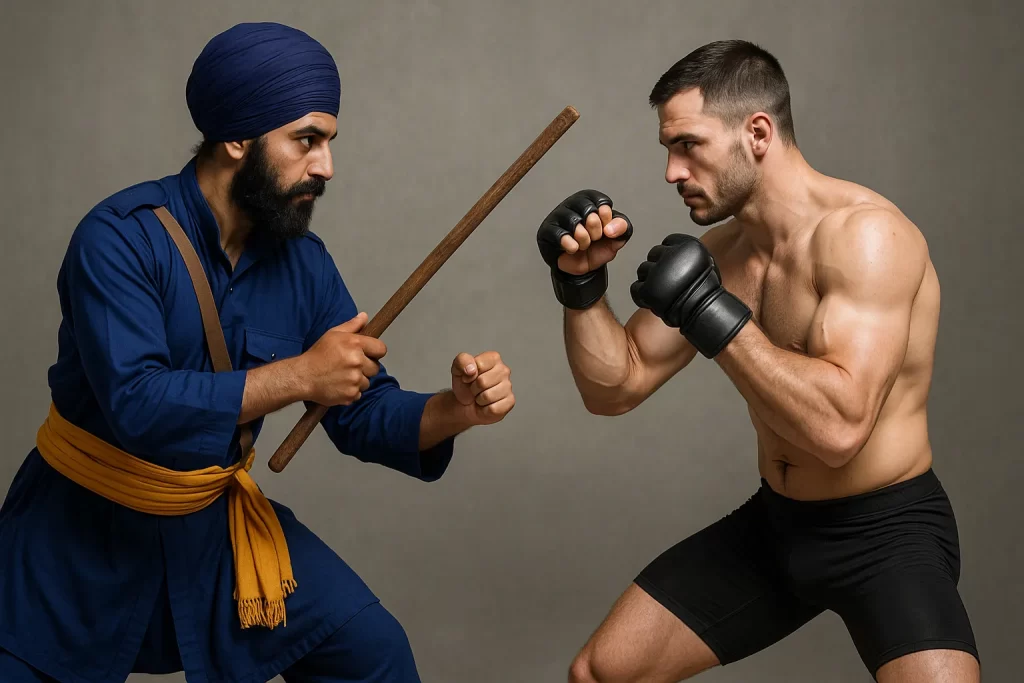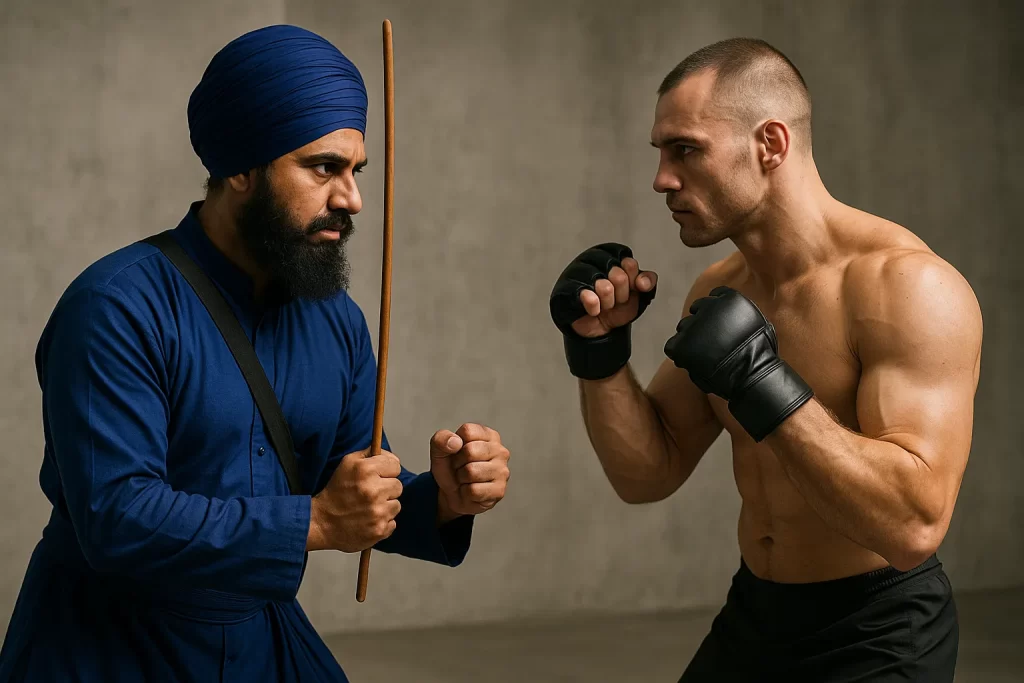The Martial Identity of Gatka
Traditional Framework, Spiritual Core
Gatka is a traditional martial art originating from the Sikh communities of Punjab, India. While today it is often practiced in ceremonial or demonstrative settings—especially during Sikh festivals like Vaisakhi—its origins are deeply rooted in battlefield effectiveness. Historically, Gatka was a sword-based art developed during the rise of the Sikh warrior class, the Khalsa, in the 17th century. It was designed for armed combat, particularly using the kirpan (ceremonial sword), lathi (stick), and other traditional weapons such as the chakram (throwing disc) and tābār (battle axe).
Philosophically, Gatka is intertwined with Sikh values like sehaj (equilibrium), nimrata (humility), and shaurya (valor). Its practice is not only physical but also spiritual—intended to cultivate mental clarity, moral discipline, and a warrior’s code of righteousness (miri-piri balance).
Combat Methodology and Training Approach
Gatka employs circular movements, fast footwork, and flowing combinations. Its techniques are optimized for fluidity and rhythm over brute force. A practitioner learns to anticipate and redirect energy rather than meet it with resistance. In combat training, solo drills (forms), paired sparring with wooden weapons, and group chakri (circular formations) are standard methods.
Weapons training begins early, emphasizing coordination and precision. Sparring is semi-contact or full-contact depending on the school, but often within a culturally respectful, ritualistic context. Physical conditioning is built through repetitive movements, not weight-based resistance training, which results in muscular endurance and agility rather than maximal strength.
Practical Use in Daily Life and Personal Development
For the average student, Gatka’s greatest value may lie not in its direct self-defense applicability but in its unique combination of physical rhythm, focus, and spiritual grounding. Practitioners often report improved posture, coordination, and a meditative sense of presence derived from its flowing drills. While less efficient against modern street violence without weapon access, Gatka can serve as a profound tool for mental discipline, cultural connection, and functional mobility.
However, Gatka demands a certain mindset and cultural openness. It’s most suitable for students interested in a martial art that transcends fighting—those looking for personal growth through movement rituals rooted in spirituality and heritage. There’s also an aesthetic and performative element, making it attractive for people who value traditional artistry and symbolism in martial practice.
The Martial Identity of MMA
Modern, Hybrid, Pragmatic
Mixed Martial Arts (MMA) represents the convergence of multiple combat systems into one competitive arena. Its roots lie in the mid-20th century, but it became globally recognized through promotions like the UFC in the 1990s. MMA combines striking, grappling, and clinch work, drawing from boxing, Muay Thai, wrestling, Brazilian Jiu-Jitsu, and others. Unlike Gatka, it has no spiritual or philosophical framework—its ethos is practical efficiency.
Philosophically, MMA reflects a secular, results-oriented mentality: what works, stays. What doesn’t, is discarded. Its core values are adaptability, toughness, and competition, rather than cultural or spiritual development.
Combat Methodology and Training Approach
MMA training is typically divided into three areas: stand-up striking, takedowns and clinch work, and ground fighting. Fighters learn to transition seamlessly between ranges, mixing strikes with takedowns or submissions. The emphasis is on effectiveness in both sport and real-world confrontation.
Training involves high-intensity conditioning, sparring, and scenario-based drills. Unlike Gatka’s flowing repetition, MMA emphasizes resistance training, anaerobic endurance, and aggressive reaction timing. It also includes mental fortitude training, particularly under pressure, as failure in live sparring has real consequences.
A common session might involve pad work for striking, wrestling drills for control, and rolling (sparring) for ground grappling. MMA is unforgiving, physically demanding, and competitive—suited for those who seek measurable progress and realistic testing of their skills.
Practical Use in Daily Life and Personal Development
MMA’s practicality in self-defense is undisputed. Techniques are tested under live conditions, and practitioners quickly learn what works when facing resistance. While the intensity might deter some, it instills resilience, confidence, and functional fitness.
However, the lack of spiritual or philosophical underpinning may be a drawback for those seeking more than physicality. Still, the mental discipline required—especially the control of fear, handling failure, and adapting under pressure—translates well into everyday life. MMA gyms often foster strong communities, though less formal than traditional dojos or akhara.
MMA is highly accessible but also demanding. Students need good recovery capacity, tolerance for discomfort, and time to invest in cross-disciplinary development. The style favors those with a competitive edge or desire for clear-cut skill acquisition and real-world effectiveness.

Comparing Foundations and Focus
| Category | Gatka | MMA |
|---|---|---|
| Origin & Philosophy | Sikh warrior tradition; spiritual and ceremonial roots | Modern sport-combat hybrid; secular and pragmatic |
| Primary Focus | Weapon-based movement, coordination, and tradition | Unarmed fighting, efficiency, adaptability |
| Training Style | Ritualized drills, weapon flow, moderate sparring | High-intensity, multidisciplinary, competitive sparring |
| Self-Defense Usefulness | Limited (weapon-based, stylized) | High (tested in realistic combat scenarios) |
| Personal Development | Emphasizes grace, humility, cultural heritage | Builds resilience, confidence, physical toughness |
| Physical Demands | Moderate (agility, rhythm) | High (strength, cardio, endurance) |
| Mental/Spiritual Impact | Meditative, spiritual alignment | Psychological toughness under pressure |
| Community Style | Ceremonial, often tied to cultural events and groups | Gym-based, modern team culture |
Comparative Performance in Structured Settings
Sparring, Competition, and Controlled Drills
In a structured environment such as a dojo, gym, or martial arts competition, the differences between Gatka and MMA become especially pronounced.
Gatka, when practiced traditionally, places less emphasis on competition and more on forms, flow drills, and choreographed sparring. Matches—when held—often follow symbolic or demonstrative rules, focusing on form, grace, and cultural storytelling rather than dominance. This creates an environment that is more inclusive and ritualized, with respect as a central value.
In contrast, MMA is built on competitive realism. Training involves constant testing of technique through live sparring, often at near-fight intensity. Athletes learn through pressure: failure, success, and tactical adaptation. Every technique is evaluated based on real-time effectiveness.
For example:
- Gatka stick sparring will often involve circular strikes, symmetrical footwork, and a fixed distance between partners, aiming to preserve rhythm and historical form.
- MMA sparring, on the other hand, may combine a jab-cross into a level change and double-leg takedown, followed by positional control on the ground and submission attempts—a chain driven by practical necessity, not cultural form.
In terms of reaction training, Gatka emphasizes timing within predictable patterns, while MMA fosters chaos navigation, where improvisation is mandatory.
Implication: For students aiming for tournament readiness, combat sports, or full-contact environments, MMA provides a more effective, feedback-rich pathway. Gatka serves better for those who seek a cultural connection, ceremonial form, and refined coordination without the physical wear of modern combat training.
Practical Application in Daily Life
Urban Safety, Personal Growth, and Emotional Resilience
While both systems offer personal benefits beyond fighting, they diverge significantly in practical daily use.
MMA’s greatest strength lies in its direct self-defense utility. The emphasis on awareness, control, and physical assertion translates well to real-life altercations. Techniques such as:
- Clinch control to avoid punches in close quarters,
- Ground scrambles to recover from disadvantageous positions,
- Striking and takedown defense for sudden threats,
are all pressure-tested and aligned with likely urban assault scenarios.
Gatka, rooted in weapon usage, faces obvious constraints in modern self-defense: people don’t walk around with kirpans or sticks. However, its value lies in movement literacy, posture, and mental stillness. The symmetric drills improve spatial awareness, while the circular footwork can enhance reaction speed and control in non-combative confrontations—such as calming situations, dealing with stress, or maintaining confidence under pressure.
A few contrasting technique examples:
- A Gatka block with the farri (curved stick) focuses on redirection with a sweeping arc.
- An MMA block might involve a simple parry and counter with a cross, prioritizing speed and minimal motion.
- Gatka’s rotational spin entry (for striking at an angle) is aesthetic and timing-dependent.
- MMA’s angle step to a leg kick or cross-hook combo is explosive and biomechanically grounded in rotational force transfer.
Thus, MMA excels in short-term protective effectiveness, while Gatka builds long-term calm, balance, and aesthetic control.
Age-Related Suitability and Developmental Trajectories
Youth, Adults, and Late Starters
Children (6–12 years):
- Gatka is particularly suitable for younger children due to its emphasis on coordination, respect, and non-contact drills. It helps instill cultural pride, basic motor skills, and discipline without encouraging aggressive behavior. Its rhythmic and ceremonial structure makes it engaging without being overwhelming.
- MMA may be intense for very young children. While many modern MMA programs adapt for kids, the combative context requires careful emotional maturity and guidance to ensure confidence-building without instilling fear or excessive competitiveness.
Teenagers and Young Adults (13–30 years):
- MMA thrives in this demographic. This is the optimal age for physical conditioning, learning resistance-based techniques, and participating in sparring with manageable recovery. Mental resilience is also developed rapidly in high-pressure situations, and those seeking to enter competitive circuits benefit the most from early exposure.
- Gatka can serve as a cultural or supplementary practice, especially for students who want movement art or a second layer of physical training alongside another martial art or sport.
Adults (30–50 years):
- MMA’s intensity becomes a challenge for many newcomers in this bracket. While not impossible, adaptation takes longer, recovery slows, and injury risk increases. Nevertheless, many MMA gyms offer modified classes focused on fitness and practical self-defense rather than full-contact sparring.
- Gatka is highly accessible in this age group. Its lower impact and emphasis on controlled movement make it an excellent entry point into martial arts for adults who seek physical activity with a meditative or cultural dimension.
Seniors (50+ years):
- Gatka is far more sustainable for seniors due to its gentler approach. The rotational drills promote joint mobility, balance, and rhythmic breathing. Seniors often find value in the art’s ritual consistency, which can be both grounding and rehabilitative.
- MMA is rarely pursued at this age unless the practitioner has prior experience and maintains high physical standards. While theoretical training or light fitness can continue, the full contact nature of MMA becomes a limiting factor.
Summary Table: Practicality by Age and Need
| Age Group | Best Fit | Why? |
|---|---|---|
| 6–12 | Gatka | Safe, non-aggressive, improves coordination and discipline |
| 13–30 | MMA | Physically optimal age, competitive and effective real-world skills |
| 30–50 | Tie (Context-dependent) | Gatka for culture/fitness, MMA for practical defense (with modification) |
| 50+ | Gatka | Low-impact, ritualized, mobility-focused |
Final Reflections
While Gatka and MMA share little on the surface, they fulfill different yet valuable roles in a martial artist’s journey. MMA offers raw realism, high adaptability, and concrete self-defense power, but demands resilience and tolerance for pressure. Gatka offers heritage, discipline, and refined movement, but is less oriented toward unarmed combat practicality.
Choosing between the two is less about which is “better,” and more about what the practitioner seeks: clarity or intensity, tradition or utility, inner calm or external dominance. For many, the answer may not be one or the other—but a fusion, where each fills the gaps the other leaves behind.


